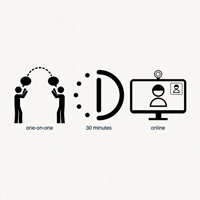Learning Tips Articles
Cooking Up Language with Signs: Peanut Butter Reindeer / Rudolph Cookies
Today I’m cooking up peanut butter reindeer / Rudolph cookies. They are a cute and fun treat that kids love. The article features a recipe and accompanying Signing Savvy word list to get you started on an interactive cooking activity that is great for spicing up language learning at home or in the classroom.
Signing Children’s Books: The Very Hungry Caterpillar's Christmas 123
The The Very Hungry Caterpillar is a classic book, loved by many. It was a favorite that I would read in my classroom. Not only is it cute and kids love it, but it also incorporates days of the week, counting, and food… if you’ve read some of my other articles, you know I love teaching signing through food! The book is discussed and paired with a pre-built Signing Savvy word list to help you get started with learning and signing the vocabulary in the book.
Signing Children’s Books: Help! I want to share the love of reading with my little one, but how???
Recently, I was contacted by a young hearing mother of a 10-month old, deaf child. This mother had two other children that are hearing, she works full time outside of the home, and now her third child was born profoundly deaf. She has tried her best to read and learn everything she can about deafness and educational options. She and her husband have decided they will be using sign language with their family. This mother did share one thing she was feeling very guilty about though; something she knew she did with her hearing children, that she was NOT doing for her deaf child… reading and sharing literacy with him on a nightly basis.
Signs That Are Close... But Not the Same - Set 8
This article is part of our “Signs That Are Close... But Not the Same” series, which highlights signs that look similar, but have different meanings. The signs discussed in this article include (1) BATHROOM vs. TUESDAY, (2) WONDERFUL vs. SUNDAY, (3) HUSBAND vs. WIFE, (4) MARRIAGE vs. HAMBURGER, and (5) MOTHER vs. VOMIT.
Common Fingerspelling Mistakes New Signers Make
One of the first concepts covered in beginning or basic sign language classes is fingerspelling. There are a few common mistakes that are made by many beginner signers related to fingerspelling. Hopefully you can recognize them in your own practice and avoid making bad habits that are difficult to break.
Signs That Are Close... But Not the Same - Set 7
This article is part of our “Signs That Are Close... But Not the Same” series, which highlights signs that look similar, but have different meanings. The signs discussed in this article include (1) BRAIN vs. THINK, (2) COLOR vs. FRIENDLY, (3) OH I SEE vs. YELLOW, (4) HISTORY vs. HARD OF HEARING, and (5) FANCY vs. FINE.
Savvy Tutoring and Savvy Chats: So Much to Sign About, So Much to Learn
We first started our Savvy Chat service over a year ago and have since added Savvy Tutoring. These ASL sessions let you meet online, one-on-one with one of our signing experts, Marta Belsky, through video chat. In that time, Marta has had the pleasure of meeting with people from around the country to chat and practice ASL skills, as well as for tutoring on vocabulary development, receptive and expressive fingerspelling skills, and more...
one-on-one
30 minutes
online
Each session is unique to meet the needs of ...
Signs That Are Close... But Not the Same - Set 6
This article is part of our “Signs That Are Close... But Not the Same” series, which highlights signs that look similar, but have different meanings. The signs discussed in this article include (1) VACATION vs. DAY OFF, (2) CONCERN vs. EXCITE, (3) PREFER vs. TASTE, (4) LONELY vs. REAL, and (5) ODD vs. LOOK FOR.
5 Tips for Overwhelmed Parents of Deaf Children
Overwhelmed… The look on the faces, or the words that came out of the mouths of almost every parent of a deaf child I’ve ever met with during a home visit. The first thing I want to say is, “Move over because you aren’t alone on that bench,” and secondly, “Stop feeling guilty about anything and everything and lets make a commitment and move forward now, looking in the rearview mirror is only good to learn from, NOT to see ...
Signs That Are Close... But Not the Same - Set 5
This article is part of our “Signs That Are Close... But Not the Same” series, which highlights signs that look similar, but have different meanings. The signs discussed in this article include (1) SATISFY vs. RELIEF, (2) COMPLICATED vs. VERY UGLY, (3) SEMESTER vs. SYSTEM, (4) GAME vs. CHALLENGE, and (5) ELECTRICITY vs. PHYSICS.
ADVERTISEMENTS


















